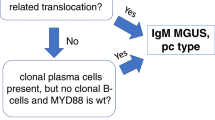Abstract Primary cutaneous B-cell lymphomas (CBCL) are a group of malignant lymphomas with apparently distinct clinicopathological and immunophenotypical features. As in other B-cell lymphomas, the accompanying benign cell population in CBCL includes a variable number of T lymphocytes whose role is not well understood. In the present study we characterized the immunophenotype of these T cells and compared it with that of the reactive T-cell population in specific skin involvement by noncutaneous B-cell malignancies. Our results indicated that most T cells in both primary and secondary B-cell lymphomas were CLA– memory/effector helper T cells which differed from the currently known CLA+ memory/effector helper T lymphocytes of the skin-associated lymphoid tissue (SALT) system. However, the endothelial CLA ligand, E-selectin, was expressed on dermal vessels. These results suggest that a B cell environment and/or a lack of epidermal involvement promote(s) the recruitment into the skin of a different, apparently less specific, subset of memory helper T cells from those seen in T-cell-mediated dermatoses.
Similar content being viewed by others
Author information
Authors and Affiliations
Additional information
Received: 24 June 1996
Rights and permissions
About this article
Cite this article
Marti, R., Hausmann, G., Estrach, T. et al. T-cell population of primary and secondary cutaneous B-cell lymphomas does not express the cutaneous lymphocyte-associated antigen (CLA). Arch Dermatol Res 289, 327–330 (1997). https://doi.org/10.1007/s004030050199
Issue Date:
DOI: https://doi.org/10.1007/s004030050199




